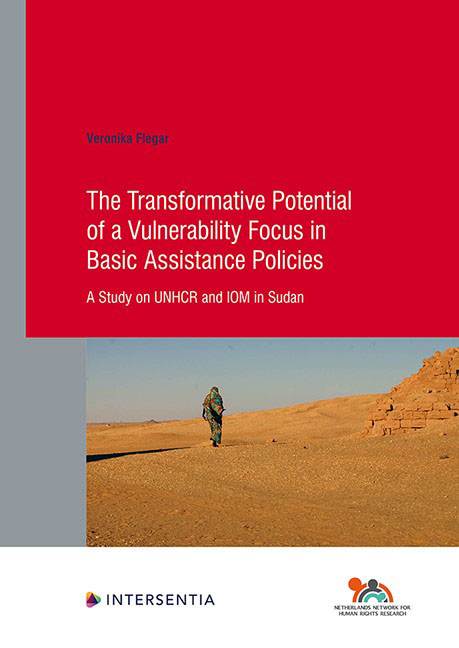 The Transformative Potential of a Vulnerability Focus in Basic Assistance Policies
The Transformative Potential of a Vulnerability Focus in Basic Assistance Policies Published online by Cambridge University Press: 11 November 2021
The previous chapters (Chapters 10–12) presented the case study's findings regarding the design and implementation of the vulnerability assessments for basic assistance at IOM's MRRC in Khartoum. This chapter evaluates these findings in light of the two dimensions of the vulnerability notion's transformative potential outlined in Chapter 2. The discussion focuses on the findings in light of the framework outlined in Chapters 2 and 3 without making extensive use of other possibly relevant literature. This choice was made in order to stay focused on this study's main research interest in the normative evaluation of the policy practice and in understanding the practical feasibility of what is viewed as normatively desirable.
First, the chapter focuses on the potential of the vulnerability-focused basic assistance policy at IOM's MRRC in Khartoum to mitigate stigmatisation and stereotyping (13.1). Subsequently, the chapter reflects upon the potential of this vulnerability focus for facilitating socio-economic participation (13.2). The chapter then reflects upon these arguments in light of the contextual constraints that appear relevant to what is deemed feasible in the design and implementation of this vulnerabilityfocused basic assistance policy (13.3). The chapter ends with a short summary in the form of concluding remarks (13.4). The chapter does not discuss all findings presented in the previous chapter but limits itself to those that appear most relevant for answering the present study's main research question on the transformative potential of the vulnerability focus in this case study's basic assistance policy. Interview quotes from the previous two chapters are sometimes used for illustrative purposes.
While the limitations of this study are dealt with extensively in Chapter 4, a few general limitations should be remembered before reviewing this case study's findings. First, the number of respondents was limited to the persons involved in the specific assessments under investigation. This means that the respondents’ individual opinions weigh heavily in the analysis. Yet, the findings are insightful since I interviewed the persons that were most directly involved in the design and implementation of the vulnerability assessment and the number of respondents is therefore thought to have been sufficient to achieve saturation.
To save this book to your Kindle, first ensure no-reply@cambridge.org is added to your Approved Personal Document E-mail List under your Personal Document Settings on the Manage Your Content and Devices page of your Amazon account. Then enter the ‘name’ part of your Kindle email address below. Find out more about saving to your Kindle.
Note you can select to save to either the @free.kindle.com or @kindle.com variations. ‘@free.kindle.com’ emails are free but can only be saved to your device when it is connected to wi-fi. ‘@kindle.com’ emails can be delivered even when you are not connected to wi-fi, but note that service fees apply.
Find out more about the Kindle Personal Document Service.
To save content items to your account, please confirm that you agree to abide by our usage policies. If this is the first time you use this feature, you will be asked to authorise Cambridge Core to connect with your account. Find out more about saving content to Dropbox.
To save content items to your account, please confirm that you agree to abide by our usage policies. If this is the first time you use this feature, you will be asked to authorise Cambridge Core to connect with your account. Find out more about saving content to Google Drive.